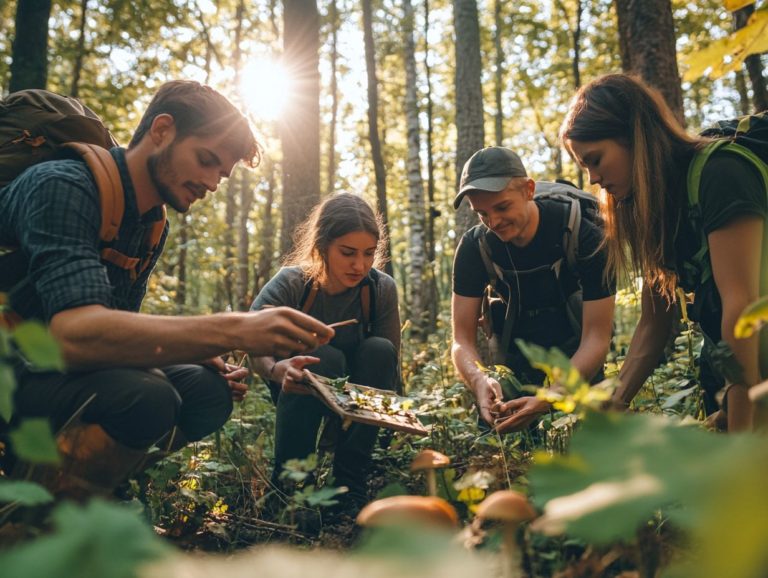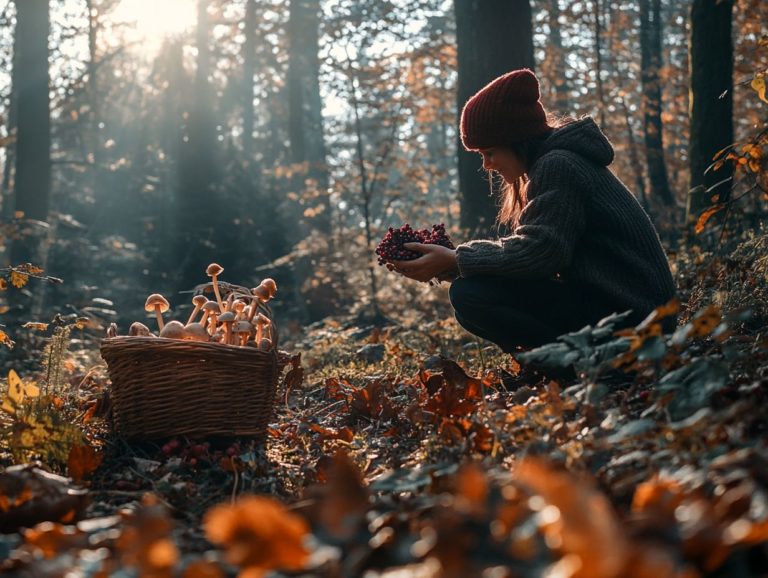The Connection Between Foraging and Community
Foraging is more than a trend. It is an ancient tradition that connects culture and community.
This exploration dives into foraging. Learn how to recognize edible plants, fungi, and their medicinal benefits.
Discover the history behind this art form. It highlights the deep connections nurtured within communities.
Whether you’re a seasoned forager or new to wild harvesting, there’s something here for everyone to discover and enjoy.
Contents
- Key Takeaways:
- The Art of Foraging
- Foraging for Food
- Foraging for Medicine
- The Connection Between Foraging and Community
- Frequently Asked Questions
- What is the connection between foraging and community?
- How does foraging affect community dynamics?
- Why is foraging important for community survival?
- How does foraging promote social cohesion within a community?
- What are some examples of foraging traditions in different communities?
- Can foraging have any negative impacts on a community?
Key Takeaways:

- Foraging is the act of gathering wild plants and fungi for food or medicine.
- Foraging has a long history and cultural significance, connecting individuals to their communities and ancestors.
- Community foraging events have benefits for individuals and the environment, promoting a sense of community and sustainable practices.
The Art of Foraging
The art of foraging is a long-standing practice that elegantly connects you with your natural environment while cultivating mental clarity and a profound understanding of sustainable food systems.
Drawing from the rich traditions of indigenous communities, foraging invites you to discover healthy foods hidden in wild strawberries, wild garlic, and a variety of herbs.
This ancient practice has also seen a revival in contemporary times, as individuals seek to enhance food production and embrace the knowledge about nature that has been lovingly passed down through generations. This movement has inspired figures like Richard Maybey and Karlos Baca.
What is Foraging?
Get ready to embark on a thrilling journey of discovering edible plants and fungi, like wild garlic and wild strawberries, from nature s pantry, all while championing sustainable food production.
This age-old practice includes a diverse array of edibles, from crunchy nuts and flavorful mushrooms to fragrant herbs and succulent fruits. Each offers unique flavors and nutritional perks that can elevate your diet.
You ll often find yourself venturing into local woodlands, wetlands, and meadows, skillfully identifying plants that are safe to eat. This not only broadens your culinary horizons but also bolsters food security by fostering self-sufficiency and decreasing reliance on commercial agriculture.
Participating in foraging cultivates a profound connection with the environment, encouraging you to understand and appreciate the intricate ecosystems that sustain these wild resources, including the ecosystem impact of foraging.
History and Cultural Significance
The history of foraging is a rich tapestry woven deeply into cultural traditions, especially among indigenous communities. Here, the knowledge of edible plants and ecological practices has been preserved through generations.
This ancient tradition offers more than mere sustenance; it creates a profound connection with the land, reflecting the rhythms of nature s bounty.
Across various regions of the globe, unique foraging methods have developed, showcasing the distinct relationships that different communities have nurtured with their environments.
Take, for example, the European tradition of wild mushroom hunting. This practice is steeped in lore that underscores the significance of seasonality and sustainability. These methods not only celebrate the expertise of traditional foragers but also reveal their intimate understanding of local ecosystems.
This knowledge holds substantial relevance in today s food systems, particularly as more people seek sustainable and locally sourced alternatives.
Foraging for Food
Foraging for food involves discovering and collecting a diverse array of edible plants and fungi, like wild strawberries and wild garlic. This practice not only fosters food sovereignty but also plays a crucial role in enhancing sustainable food systems.
Join the foraging movement and reap the rewards of nature s bounty!
Edible Plants and Fungi

Foraging means recognizing various edible plants and fungi. Wild strawberries and mushrooms like Pleurotus spp. can elevate your meals!
Edible greens like dandelion leaves and lamb’s quarters offer great nutrition. They also add unique flavors to your salads and saut ed dishes.
The nutritional profiles of these wild finds can vary greatly; for instance, many wild greens are rich in vitamins A and C, while mushrooms often boast essential minerals like selenium.
However, caution is key, especially with mushrooms, as misidentifying them can lead to toxic surprises. Familiarizing yourself with important characteristics such as cap shape, gills, and habitat will ensure a safe foraging experience and deepen your appreciation for nature’s offerings.
Harvesting Techniques
Effective harvesting techniques focus on sustainable practices. They promote the growth of wild plants and build community through sharing food.
Honor the delicate balance of ecosystems. Selective harvesting means taking only what you need to keep plant populations healthy.
Engaging in community-led initiatives such as local foraging workshops or seasonal potlucks can spark collaboration. These gatherings deepen your knowledge and nurture a sense of stewardship in your ecological practices.
Foraging for Medicine
Foraging for medicine allows you to collect powerful medicinal plants and herbs. Each offers remarkable health benefits and connects you to nature’s wisdom.
Medicinal Plants and Herbs
Medicinal plants and herbs provide a wealth of health benefits. Traditional foragers have valuable knowledge about effective remedies from local flora.
These plants, steeped in centuries of indigenous wisdom, act as natural treatments for various ailments. Take dandelion, often called a weed. It’s praised for detoxifying and aiding digestion.
Then there’s stinging nettle, traditionally utilized to alleviate arthritis pain and packed with nutrients. Modern herbalists tap into the anti-inflammatory magic of turmeric, a wellness superstar.
By blending traditional practices with contemporary applications, foragers like you can unlock a wealth of healing potential from your environment.
Preparation and Usage
Preparing foraged goods like wild garlic pesto and fresh elderflower tea turns natural treasures into nourishing meals.
Wild garlic is rich in vitamins A and C, which support your immune system. Blend it into a pesto for a delightful pasta or grilled veggie sauce.
Steeping elderflowers in hot water creates a fragrant tea that hydrates and has anti-inflammatory properties. By incorporating these foraged ingredients into your meals, you deepen your connection with nature and boost your well-being.
The Connection Between Foraging and Community

The connection between foraging and community is truly remarkable. Engaging in activities like community foraging events does more than simply share food; it cultivates a sense of belonging and deepens your appreciation for local ecosystems and urban agriculture.
These gatherings enrich your community ties and enhance your understanding of the local environment.
Community Foraging Events
Community foraging events provide you with a remarkable opportunity to connect with others and explore local plants. You can engage in food sharing, all while strengthening your ties to urban agriculture initiatives.
These gatherings cultivate not just a sense of belonging. They also highlight the significance of understanding your local ecosystem. You ll have the chance to discover edible plants, mushrooms, and herbs that flourish in your neighborhood, acquiring practical skills that elevate your foraging prowess.
By participating in workshops and guided walks, you ll uncover the rich history and cultural significance of these natural resources. This promotes sustainable practices and inspires a profound appreciation for biodiversity. You ll be encouraged to advocate for urban green spaces, ultimately contributing to a healthier environment for all.
Benefits for Individuals and Communities
Foraging enhances food production and supports food sovereignty, offering profound advantages for individual health and community resilience.
Foraging offers exciting benefits for you and your community! It enhances your health through fresh, wild foods and fosters stronger social connections through shared experiences, highlighting the importance of local foraging networks.
This age-old practice helps you connect more with nature while simultaneously creating social ties as you and others embark on quests for edible treasures.
You may notice how foraging can revitalize a neighborhood. It sparks local workshops where enthusiasts exchange tips and recipes, ultimately strengthening ties among residents.
There are also economic benefits to consider. Local artisans and small businesses thrive by offering unique, sustainably sourced products. Heartwarming testimonials highlight families coming together, discovering not only food but also a renewed appreciation for their environment and a vibrant community spirit.
Environmental Impact
The environmental impact of foraging can be quite significant. It supports local food sources and helps you notice plants around you, allowing you to reconnect with nature on a profound level.
By sourcing your food locally and mindfully, foraging cultivates a deeper appreciation for biodiversity and the delicate balance of ecosystems. However, it’s essential to approach this practice with caution; overharvesting certain species can jeopardize local flora and disrupt habitats.
On the upside, foraging imparts valuable lessons about the interconnectedness of all life forms, nurturing a sense of stewardship within you. As you actively engage with your environment, you inevitably become more invested in its protection. This often leads to stronger conservation efforts that uphold ecological integrity and resilience.
Frequently Asked Questions
What is the connection between foraging and community?

The connection between foraging and community is about how people gathering wild food interact within their community. Understanding the role of community in foraging practices can significantly impact the dynamics and cohesion of a community.
How does foraging affect community dynamics?
Foraging can affect community dynamics in several ways. First, it can create a sense of interdependence and cooperation among foragers, who often rely on each other for successful hunting or gathering. Additionally, understanding the role of community in sustainable foraging can help mitigate resource competition and conflict within a community.
Join a local foraging event today and discover the joys of connecting with nature and your neighbors!
Why is foraging important for community survival?
Foraging is key for community survival. It offers a diverse and reliable food source.
This practice builds social bonds and resilience. People learn to share resources and support each other during tough times.
Foraging creates chances for teamwork and fosters belonging and cooperation, which are vital for a united community. Understanding the future of foraging communities can further enhance these connections.
What are some examples of foraging traditions in different communities?
Foraging traditions differ by culture. Examples include fishing in coastal areas and hunting among indigenous groups.
Urban foraging is also popular, where individuals harvest wild plants and fruits from public spaces.
Can foraging have any negative impacts on a community?
Yes, if not managed properly, foraging can harm a community. Overhunting or overgathering can use up food sources and lead to conflicts.
Foraging practices that damage the environment can also cause long-term problems for the community.






